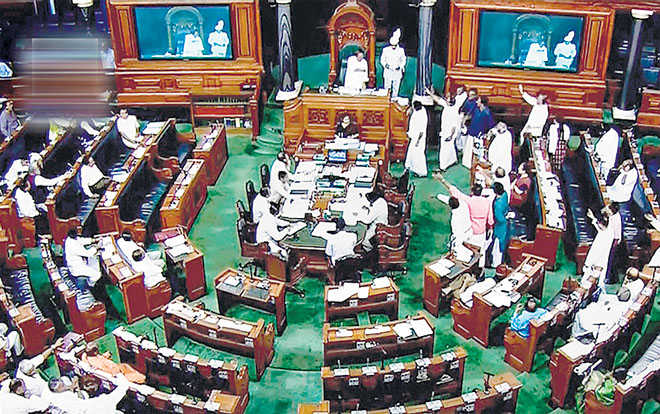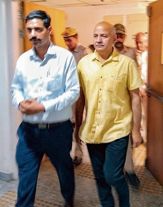
As one: How the vote goes will be the next visible indicator of a ‘united’ Opposition front.
Ujjwal K Chowdhury
AROUND 12 Opposition parties held a meeting on July 16, where they agreed to collectively bring a vote of no-confidence against the Modi government in the ongoing Monsoon Session. The motion, brought on Tuesday and accepted on Wednesday, shall go for vote on Friday, as noted by Lok Sabha Speaker Sumitra Mahajan. The Opposition parties are demanding grant of special status to Andhra Pradesh, apart from raising the failures of the government on issues such as lynching, atrocities against women and Dalits, dilution of laws meant for SCs, attempts to abolish the reservation policy, the falling rupee, unemployment, farmerr’ distress, alleged tampering of EVMs, the J&K situation and foreign policy.
Apart from the Congress, the most vocal among all parties to bring forth the motion has been the Telugu Desam Party, which tried to bring this in the last Lok Sabha session as well. As a former NDA ally, the TDP is well aware that barring any major twist over the next few days, the motion is unlikely to endanger the Modi government. And yet, it is celebrating the acceptance of the motion by the Speaker as a success. Kesineni Srinivas, the TDP parliamentarian who moved the motion, said the trust vote was less about testing the strength of the BJP government and more about its failures.
In India, a motion of no confidence can be introduced only in the Lok Sabha. It is admitted for discussion if a minimum of 50 members of the House support it. If the motion carries, the House debates and votes on it. If a majority of members vote in its favour, the motion is passed and the government is bound to vacate the office. Acharya Kripalani moved the first-ever such motion on the floor of the Lok Sabha in 1963, immediately after the disastrous India-China War. As of July 2018, 26 no-confidence motions have been moved. PM Indira Gandhi faced the most number of no-trust motions, 15, followed by Lal Bahadur Shastri and Narasimha Rao (thrice each), Morarji Desai (twice) and Nehru, Rajiv Gandhi, Vajpayee, and now Modi (one each). All motions have been defeated except when Morarji Desai resigned during the discussions on in 1979.
With the anti-defection law, the vote of no-confidence has no relevance. If an absolute majority party issues a whip to party members to vote in favour of the government, it is impossible to remove the government.
In the present case, if the Opposition can prove its majority in the House, the Modi government will fall. However, the government expects to get the support of at least 314 MPs in the Lok Sabha, which has an effective strength of 535 members. The government needs the vote of only 268 members to defeat the motion. So, NDA’s win is guaranteed.
Even if all BJP members, minus all allies, vote against the motion, which they are now bound to by dint of the anti-defection law and whip of the ruling party, the government will survive.
But the motion will give a clear picture about the position of disgruntled NDA allies, like the Shiv Sena and to an extent, JD (U). It will also give the position of parties like BJD and Telengana Rashtra Samiti, who have largely maintained a middle path between NDA and the Opposition. Both the Congress and the BJP need to know the positions of these parties during the debate, and the final voting, to strategise on alliances for the ensuing Lok Sabha polls, as both need an alliance to make the winning cut.
The Congress desperately needs to stitch a united opposition front to combat the war chest and election machinery, including the BJP’s cyber army. An opposition alliance is not just political, it is also a social alliance as each regional party brings with it a few specific castes or linguistic groups. The no-confidence motion debate, issues raised and the voting will give cue to the scope and size of this alliance, without which no single party can stand the current enormity of the BJP ruling India and 20 other states.
The TDP tried bringing in the motion in the last session. Telangana was carved out of erstwhile Andhra Pradesh, also on the promise of a special status to the truncated state and a generous fund to help build its capital city Amravati, and compensate the loss of revenue from the commercially thriving erstwhile capital city of Hyderabad, which has gone to Telangana. The Modi government has not fulfilled this promise, and it is being perceived as a failure of Chandrababu Naidu within his electorate. To ameliorate his electoral fortunes, the TDP supremo has a strong rationale to up the ante against the Modi government.
A former minister of the Vajpayee government and rebel BJP leader, Yashwant Sinha had launched a new political outfit, National Forum, in early 2018 to expose the crime and corruption in the Modi government. Distressed politicians from the BJP (including Shatrughan Sinha) as well as opposition parties had sent their senior emissaries to be its members. Although positioned as a non-political group, it noted that it would campaign against the Modi government. The forum had organised several meets of Opposition leaders and paved the way of a united opposition force evolving today.
The BJP failed to win in Karnataka in the last Assembly polls, in spite of being the largest party, while the second largest party Congress (but with a greater vote share than BJP) came around to support the JD (S) to form the government. The JD (S)-Congress government was ushered in with a lot of fanfare and in the presence of Opposition leaders of 16 parties. This was the second major development in increasing the index of Opposition unity.
The coming together of Samajwadi Party, Bahujan Samaj Party and Rashtriya Lok Dal in Uttar Pradesh, ensuring the victory of the joint opposition candidates in Phulpur, Gorakhpur and Kairana byelections for the Lok Sabha, was the third major landmark in this rising index.
Now, the Opposition wants to make the closing of arms by all Opposition parties (may be with support from some fence-sitters and perhaps at least one of the NDA allies) during the no-confidence motion debate and voting as the next and most visible landmark before a formally constituted united Opposition front takes shape. This is irrespective of the motion results. The Opposition wants to use the opportunity to highlight before the nation the failure of the government to fulfil its promises.
Academic, media studies


























